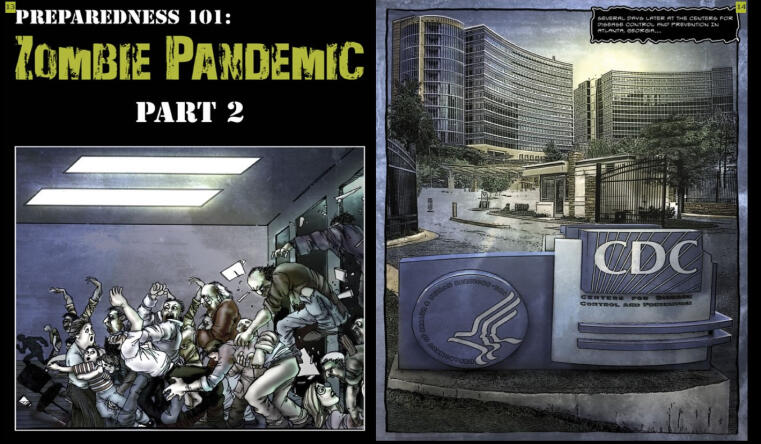The worst of all plagues
By Historian Katharina Wolff

What is the very worst thing about an epidemic? The dead? The survivors? The ubiquitous fear? The uncertainty about how things will turn out? If we wanted to intensify all this in order to achieve the maximum of terror in a fictional adaptation of the theme, what would this look like ultimately?
Before microscopes, there were many diverse theories about the nature of the plague. Epidemics were caused by miasma or a dyscrasia of the bodily fluids, or by the punitive hand of God scything people down across Europe. In terms of theories of disease, the Middle Ages lasted until well into the 19th century: it took that long for the old paradigms to be replaced by cellular pathology and microbiology, which soon ushered in the first attempts at immunization and the first medicines. In 1909, Paul Ehrlich was able to counter the dreaded syphilis with the drug Salvarsan, which was followed by other antibiotics to combat the old terrors. In 1908, the physician and historian of epidemics, Friedrich Sticker, could look back with humour at past times:
"In order to put the significance of the discovery of the plague bacillus for the natural history of the plague into perspective, it does not seem superfluous to go into a few words about earlier ideas and views on the cause of the plague. Religious premonitions, poetic imaginings, philosophical fantasies are at odds with each other; teleological opinions and scientific views and findings alternate according to the spirit of the times and the education of the spectator. The simple-minded man marvels and sees angry and punishing supernatural powers; the scholar does not fail to understand anything, he immediately talks about cosmic and telluric testimonies; the thinker suspects natural connections and forms comprehensible parables and terms such as plague tinder, plague seeds, plague germs. Away from them, the researcher works and does not rest until he sees the presumed, the probable, the almost certain as certain and can make it visible to others."
What had been valid for thousands of years, what people had tried to depict by means of bone-men, mounted demons, plague saints, plague arrows, and those wasting away (see the contributions by Eva Krems, Jens Niebaum, and Matthias Sandberg in this dossier), but what itself had always been without a face – all this now seemed to have been overcome. Societies were entering a new, brave age, with technologies and pharmaceuticals accompanying them into a much safer world – or were they?
In the past 25 years, however, something diffusely ominous has emerged with increasing certainty about developments of resistance and simultaneously growing mobility, and this where such (un)consciousness is reflected: namely, in pop culture. One early example that is not too allegorical is Wolfgang Petersen’s film Outbreak (1995). Clearly inspired by Ebola, it depicts the case of a small American town where a haemorrhagic fever breaks out. In the years following, however, the film depicts the diffuse nature of the sense of threat hanging over the town. That “something” could take modern societies by surprise and overrun them, that “something” could unhinge the world despite all security policies, technology, opportunities to predict the future, and research – this is an idea that numerous works of pop culture have shared in recent decades, including not only epidemic scenarios, but also Roland Emmerich’s climate drama, The Day After Tomorrow (2004). But precisely the fear of a pandemic recurred regularly, in the guise almost of a fantasy or science-fiction scenario with very realistic traits: namely, as a zombie film, streaming format, computer and online game, and board game.
Filmic realizations of the fear have not only appeared in cinemas, such as Francis Lawrence’s I Am Legend (2007) and Marc Forster’s World War Z (2013); various streaming formats that have had great success worldwide, such as The Walking Dead (AMC, 2010-19) and Game of Thrones (HBO, 2011-19), also deal with zombie plagues, or feature them at critical points. We should briefly reconsider the term “zombie”. Originating from the Haitian town of Vodun, a zombie can only be brought to life with the help of a priest. Zombies first became contagious in the imagination of 20th-century adaptations in pop culture. The particular terror lies in the resolution of the idea introduced at the beginning of this contribution: namely, in the heightening of what in any case overwhelms people in times of epidemics. Where Giovanni Boccaccio still lamented the corpses lying in the streets around the middle of the 14th century, these corpses even run after people in the stories of the 20th and 21st centuries. Boccaccio expressed his dismay at the fact that families no longer stood by each other, husband and wife abandoned each other, and the epidemic divided many. If we look at a scene from the end of the film World War Z, when bulldozers push mountains of corpses and mountains of zombies together, and the grey mass of infected and dead people is set alight, then it becomes clear that these are no longer patients, people who are mourned, treated, or buried. At the moment of infection, they are turned by brothers, friends, daughters, and other loved ones into enemies. They are robbed of any human traits to become Plague 2.0, the incarnation of the disease itself, perhaps even endowed with malignant intelligence in their own right. In a seemingly safe world, in which everyone can travel anywhere, in which responsibility for one’s own health is transferred to the highly differentiated expertise of specialist cultures, a diffuse fear grows in the (sub)conscious mind – a fear that there might after all be something that could endanger this safety.
The metaphorical embodiment of this worst of all plagues, the essence of plagues, are in the 21st century the zombies. They represent the epitome, the maximum, the worst of all plagues, which deprives the human being of what makes her what she is – which dehumanizes the human.

